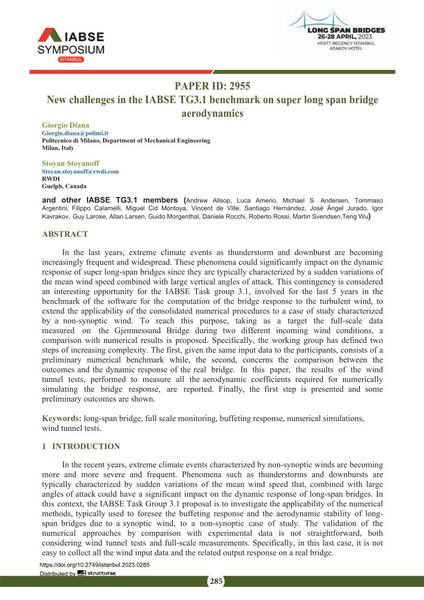New challenges in the IABSE TG3.1 benchmark on super long span bridge aerodynamics

|
|
|||||||||||
Bibliografische Angaben
| Autor(en): |
Giorgio Diana
(Politecnico di Milano, Department of Mechanical Engineering Milan, Italy)
Stoyan Stoyanoff (RWDI, Guelph, Canada) Andrew Allsop (IABSE TG3.1 Member) Luca Amerio (IABSE TG3.1 Member) Michael S. Andersen (IABSE TG3.1 Member) Tommaso Argentini (IABSE TG3.1 Member) Filippo Calamelli (IABSE TG3.1 Member) Miguel Cid Montoya (IABSE TG3.1 Member) Vincent De Ville (IABSE TG3.1 Member) Santiago Hernández (IABSE TG3.1 Member) José Ángel Jurado (IABSE TG3.1 Member) Igor Kavrakov (IABSE TG3.1 Member) Guy Larose (IABSE TG3.1 Member) Allan Larsen (IABSE TG3.1 Member) Guido Morgenthal (IABSE TG3.1 Member) Daniele Rocchi (IABSE TG3.1 Member) Roberto Rossi (IABSE TG3.1 Member) Martin Svendsen (IABSE TG3.1 Member) Teng Wu (IABSE TG3.1 Member) Claudio Mannini (IABSE TG3.1 Member) Niccolò Barni (IABSE TG3.1 Member) |
||||
|---|---|---|---|---|---|
| Medium: | Tagungsbeitrag | ||||
| Sprache(n): | Englisch | ||||
| Tagung: | IABSE Symposium: Long Span Bridges, Istanbul, Turkey, 26-28 April 2023 | ||||
| Veröffentlicht in: | IABSE Symposium Istanbul 2023 | ||||
|
|||||
| Seite(n): | 285-293 | ||||
| Anzahl der Seiten (im PDF): | 9 | ||||
| Jahr: | 2023 | ||||
| DOI: | 10.2749/istanbul.2023.0285 | ||||
| Abstrakt: |
In the last years, extreme climate events as thunderstorm and downburst are becoming increasingly frequent and widespread. These phenomena could significantly impact on the dynamic response of super long-span bridges since they are typically characterized by a sudden variations of the mean wind speed combined with large vertical angles of attack. This contingency is considered an interesting opportunity for the IABSE Task group 3.1, involved for the last 5 years in the benchmark of the software for the computation of the bridge response to the turbulent wind, to extend the applicability of the consolidated numerical procedures to a case of study characterized by a non-synoptic wind. To reach this purpose, taking as a target the full-scale data measured on the Gjemnessund Bridge during two different incoming wind conditions, a comparison with numerical results is proposed. Specifically, the working group has defined two steps of increasing complexity. The first, given the same input data to the participants, consists of a preliminary numerical benchmark while, the second, concerns the comparison between the outcomes and the dynamic response of the real bridge. In this paper, the results of the wind tunnel tests, performed to measure all the aerodynamic coefficients required for numerically simulating the bridge response, are reported. Finally, the first step is presented and some preliminary outcomes are shown. |
||||
| Stichwörter: |
Windkanaluntersuchungen numerische Simulationen
|
||||
